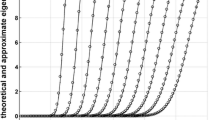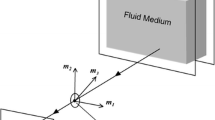Abstract
An algorithm is presented to determine displacements thanks to the identification method. Its main properties are described: no link with the particle size, measurement of the velocity distribution. Determination of effects of PIV parameters on displacement identification is made. Parameters used are noise, bias, velocity distribution. Therefore, we can define a validity domain of PIV parameters for identification and compare it with the domain of cross correlation. The identification validity range is based on 70% of isolated particles, on a displacement norm and on displacement gradients corresponding to less than half the size of the interrogation cell and to 10% of the average velocity. The comparison with cross correlation domains indicates that the cross correlation is more robust. However, the identification method is interesting because of the possibility of displacement distribution measurement. We use it to measure the decreasing of the turbulence intensity for a grid-generated turbulence.
Similar content being viewed by others
Abbreviations
- FFT:
-
Fast Fourier Transform
- s1,s2:
-
two successive and distinct synthetic PIV images,S1,S2: FFT ofs1 ands2 respectively
- a :
-
average displacement betweens1 ands2
- g :
-
dispersion of displacement arounda
- h :
-
impulse response of a stationary linear system,H: FFT ofh
- \(\varphi _{s_1 s_2 } \) :
-
cross spectral density ofs 1 ands 2,\(\Phi _{s_1 s_2 } \): FFT of\(\varphi _{s_1 s_2 } \)
- \(\varphi _{s_1 } \) :
-
spectral density ofs 1,\(\varphi _{s_1 } \): FFT of\(\varphi _{s_1 } \)
- W :
-
spectral window, FFT of Blackman’s window
- C :
-
average number of particles per volume unit
- SNR:
-
Signal to noise ratio
- %EV:
-
percentage of erroneous vectors
References
Adrian, R. J., Particle-imaging techniques for experimental fluid mechanics, Ann. Rev. Fluid Mech., 23 (1991), 261–304.
Comte Bellot G. and Corrsin S., The use of a contraction to improve the isotropy of a grid generated turbulence, J. of Fluid Mech., 25 (1966), 657.
Fayolle, J. et al., Displacements identification in particle image velocimetry, Compte Rendu á l’Academie des Sciences, t. 321, IIb, No. 7, 273–278, (1995).
Fayolle, J., Study of images processing algorithms for the motion determination of unrigid objects, application to displacement determination in flows, PhD thesis, Univ. of Saint-Etienne, (1996).
Grant, I. and Liu, A., Accuracy considerations in incoherent analysis of PIV images, Applied Optics, 28–21 (1989), 4508–4510.
Keane, R. D. and Adrian, R. J., Theory of cross-correlation analysis of PIV images, Applied Scientific Research, 49 (1992), 191–215.
Okuno, T. and Kinoshita, T., A method of velocity field measurement using flow images, Proc. of the 4th Osaka symposium on flow measurement techniques (Osaka, Japan), (1987), 161–172.
Okuno, T., Some examples of image measurement in two dimensional flow field, Proc. of FLUCOME’91, (1991a), 623–628.
Okuno, T.,Velocity field measurement by flow images with Fourier transformation, J. of Kansai Shipbuilding Assoc., No. 215 (1991b), 69–74.
Prabel, F., Study of jet turbulent structure of a circular jet by image analysis methods, PhD thesis, ECL Lyon, France, (1985).
Prasad, A. K. et al., Effect of resolution on the speed and accuracy of PIV interrogation, Exp. in Fluids, 13 (1992), 105–116.
Prasad, A. K. and Adrian, R. J., Stereoscopic particle image velocimetry applied to liquid flows, Exp. in Fluids, 15 (1993), 49–60.
Riou, L., Calibration methods of a stereoscopic system designed for flow displacement measurement in 2D and 3D, Ph.D. thesis, University of Saint-Etienne, France, (1999).
Rouland, E., Study and development of particle image cross-correlation. Application to hydrodynamic tunnel flows, PhD thesis, Rouen University, (1994).
Spiegel, M. R., Elementary sampling theory, (1961), 141–144, Schaum publishing Co, New York.
Author information
Authors and Affiliations
Additional information
Author Profile Jacques Fayolle: He received his postgraduate diploma “Images” in 1993 and the PhD degree of “Image analysis and image processing” in 1996 from the Saint-Etienne university. He is currently an assistant professor at the Institut Universitaire Professionnalisant Télécommunications and at the research laboratory, Traitement du Signal et Instrumentation — UMR CNRS 5516 at Saint-Etienne. His current research interests include the determination of motion or deformation by image processing applied to fluid mechanics and to biomechanics. Others interest fields are pattern recognition through feature points characterization, camera calibration, segmentation of fuzzy objects, and the applications of the continuous wavelet transform. The main application of his research is the determination of displacements in turbulent flows or of some targets on human body.
Thierry Fournel: He is an assistant professor at the Technology Institute of Jean Monnet University (Saint-Etienne, France). Since 1989, he works as researcher in the Laboratory “Traitement du Signal et Instrumentation”. His current research topics concern the development and the calibration of Stereoscopic Digital Particle Image Velocimetry (SDPIV) systems.
Philippe Gervais: He obtained his PhD in Energy Sciences at the “Falculté des sciences de Paris” in 1984. He is an assistant professor at Institut National des Sciences Appliquées of Lyon, France. His major research areas concern impinging jets and convection heat transfer problems for low velocity airflows. These topics are experimentally covered with laser visualization technique and have been resulted in PIV tools desing. His current research activities deal with development of thermal diffusivity measurement apparatus using both flash and harmonic techniques, respectively for low (130K to 400K) and high (500 to 3000) temperatures. From September 1998 to July 1999, he had been working as an invited professor in the Department of Chemical Engineering at McGill University at Montreal, Canada.
Rights and permissions
About this article
Cite this article
Fayolle, J., Fournel, T. & Gervais, P. Comparison of PIV parameters effects on displacement identification and cross correlation. J Vis 3, 253–265 (2000). https://doi.org/10.1007/BF03181848
Received:
Revised:
Issue Date:
DOI: https://doi.org/10.1007/BF03181848




